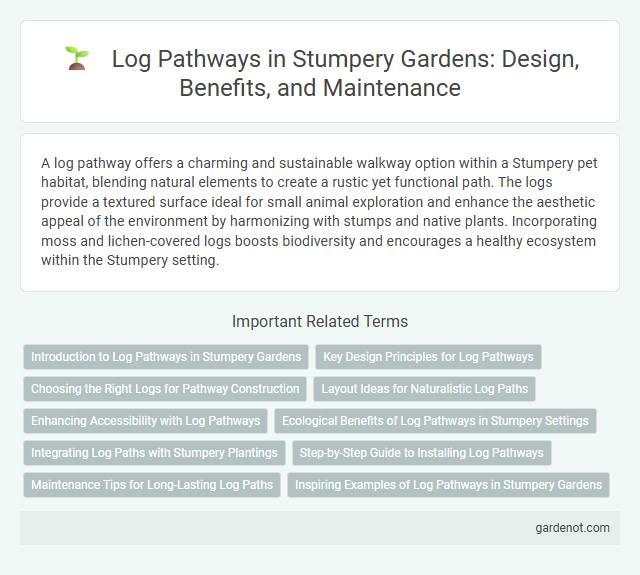A log pathway offers a charming and sustainable walkway option within a Stumpery pet habitat, blending natural elements to create a rustic yet functional path. The logs provide a textured surface ideal for small animal exploration and enhance the aesthetic appeal of the environment by harmonizing with stumps and native plants. Incorporating moss and lichen-covered logs boosts biodiversity and encourages a healthy ecosystem within the Stumpery setting.
Introduction to Log Pathways in Stumpery Gardens
Log pathways in stumpery gardens serve as natural walkways that blend seamlessly with the woodland aesthetic, providing sturdy, eco-friendly surfaces made from felled trees and branches. These pathways promote biodiversity by offering habitats for fungi, insects, and small mammals while enhancing garden accessibility and visual interest. Their organic textures and irregular shapes complement the rustic charm of stumperies, making them a sustainable choice for garden design.
Key Design Principles for Log Pathways
Log pathways in stumpery design emphasize natural integration with surrounding flora, ensuring logs are positioned to promote moisture retention and support fungal growth. Key design principles include selecting varied log sizes for aesthetic diversity, arranging logs to create stable, walkable surfaces, and aligning pathways to guide visitors through the shaded garden environment. Incorporating native wood species enhances ecological benefits and fosters habitat creation for woodland creatures.
Choosing the Right Logs for Pathway Construction
Selecting the ideal logs for a stumpery pathway involves considering durability, size, and resistance to decay. Hardwood logs like oak, cedar, and chestnut offer longevity and natural insect resistance, making them optimal choices. Properly seasoned logs with minimal moisture content prevent rotting and ensure a stable, long-lasting pathway structure.
Layout Ideas for Naturalistic Log Paths
Create winding log pathways by arranging various sizes of logs to mimic natural forest trails, enhancing organic flow and visual interest. Incorporate moss and small plants between logs to blend the path seamlessly into surrounding vegetation, promoting a lush, woodland atmosphere. Use irregular spacing and varying log thicknesses to avoid uniformity, ensuring the log path complements the stumpery's wild, textured aesthetic.
Enhancing Accessibility with Log Pathways
Log pathways in stumperies enhance garden accessibility by providing stable, natural walking surfaces that prevent soil compaction and erosion. Using large, flat logs sourced sustainably, these pathways offer slip-resistant traction, making paths safer in wet conditions. Incorporating log pathways supports biodiversity by creating microhabitats beneath logs, benefiting fungi and invertebrates.
Ecological Benefits of Log Pathways in Stumpery Settings
Log pathways in stumpery settings enhance soil health by promoting natural decomposition, which recycles nutrients and supports microbial activity. They provide habitat for beneficial insects and fungi, contributing to increased biodiversity and ecosystem resilience. These pathways also help manage moisture levels, reducing erosion and improving water retention in woodland gardens.
Integrating Log Paths with Stumpery Plantings
Integrating log pathways within stumpery plantings enhances both aesthetic appeal and ecological function by providing a natural, rustic walkway that complements the intricate arrangement of decaying wood and shade-loving plants. These log paths support biodiversity by offering habitats for fungi, insects, and small wildlife while guiding visitors through the textured landscape. Careful placement ensures minimal soil disturbance, promoting healthy root growth and moisture retention around ferns, mosses, and woodland perennials.
Step-by-Step Guide to Installing Log Pathways
Creating a log pathway begins with selecting durable hardwood logs, ensuring they are properly seasoned to prevent rot and insect damage. Prepare the ground by leveling the soil and laying a weed barrier fabric before positioning the logs tightly together, securing them with landscape stakes if necessary. Finish the installation by filling gaps with gravel or mulch to improve drainage and stability, providing a rustic yet functional garden walkway.
Maintenance Tips for Long-Lasting Log Paths
Regularly remove debris and fallen leaves from log pathways to prevent moisture retention and wood rot. Apply natural wood preservatives or sealants to protect logs from insect damage and weathering. Ensure logs are firmly embedded and maintain proper drainage around the path to reduce moss growth and extend durability.
Inspiring Examples of Log Pathways in Stumpery Gardens
Log pathways in stumpery gardens create natural, textured walkways that blend seamlessly with woodland elements, enhancing biodiversity by providing habitats for insects and fungi. Examples like the Hidcote Manor Garden feature carefully arranged logs that guide visitors through shaded, moss-covered landscapes while promoting sustainable garden design. These pathways not only offer aesthetic appeal but also support ecological health by encouraging native flora and fauna to thrive.
Log pathway Infographic

 gardenot.com
gardenot.com